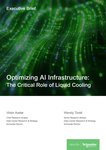In line with increased AI usage and data center demand globally, earlier this year, the UK’s Prime Minister announced plans to develop dozens of data centers to support ‘AI Growth Zones’ across the country. While this expansion is a great opportunity for the UK economy, there are numerous hurdles that must be overcome during data center development in the UK – from policy to planning issues – to ensure they deliver on their promise. Perhaps most challenging of all is the need to ensure that data center infrastructure can keep up with the demands of AI and next-generation technologies.
AI requires a significant amount of computing power which, in turn, generates a lot of heat, that traditional air-cooling methods cannot keep up with. When a data center overheats, it fails. So, what technologies need to be adopted to help the UK make the most of AI and the planned data center expansion?
Challenges in data center development
The growing demand for digital infrastructure, fueled by the surge in AI, has intensified competition for suitable land to build data centers. This scarcity (particularly in London), coupled with the rise in construction and operational costs, makes it difficult to establish data centers in the most efficient and cost-effective manner. Similarly, an over-reliance on well-established technology clusters (such as West London) can increase resource restraints and vulnerability to power outages and downtime. With UK policy frameworks around data centers still evolving, discussions are ongoing around security, energy consumption, and specific regulatory needs.
In recent years, the energy consumption of data centers has surged and will continue to do so. Advanced AI technologies and high-density workloads demand significantly more processing power, pushing the limits of traditional cooling systems.
Average rack power density in data centers has more than doubled in just two years, rising from 8kW to 17kW per rack. This figure is expected to rise to as high as 30kW by 2027, given the surge in AI workloads. Typical data centers can have anywhere from several hundred to several thousand racks, with traditional air cooling methods typically struggling to thermally manage anything over 50kW per rack. Many data centers now have rack power densities above this level, suggesting that air cooling systems will soon become ineffective.
Similarly, traditional methods demand a high level of energy consumption to keep AI chips operating at optimal temperatures. Given the energy-intensive nature of air cooling and it being unlikely to keep up with cooling demands, the data center industry is reaching a critical juncture: stifle the capabilities of AI technologies by not integrating effective thermal management, or investing in a more effective, future-thinking approach to cooling?
The transition to liquid cooling
In response to this high-energy, lower-impact approach to cooling, data centers have begun to rely on liquid cooling technologies – a more efficient approach to thermal management that is effective at cooling high-density servers. Both immersion cooling and direct-to-chip cooling are types of liquid cooling technologies used in data centers to target heat directly at its source, dramatically improving efficiency and allowing data centers to handle far greater compute densities.
Immersion cooling submerges entire servers in non-conductive liquid, while direct-to-chip cooling delivers liquid – whether that be water or a specialized coolant – directly to specific high-heat components through specialized heat sinks or cold plates. By keeping AI chips operating at optimal temperatures, liquid cooling aims to decrease downtime, maximize operational efficiency, and future-proof the data center industry to tackle increased AI computing power. A recent survey – detailed in Castrol’s Dipping Point Report – indicated that nearly three-quarters of data center leaders believe immersion cooling is the only answer to meet increasing computing power demands.
The revolution cannot wait
Innovation and research and development (R&D) capabilities will be essential for data center companies to maintain a competitive advantage and keep pace with the growth of AI, but they can represent significant investment.
Castrol’s Liquid Cooling research facility at Pangbourne, is at the forefront of solving critical heat management challenges in computing, strengthening the UK’s position as a hub for technological innovation. A recent £50 million ($67.9m) investment in Pangbourne is helping to develop new immersion fluids. This facility has the potential to give data center companies access to extensive testing facilities that could potentially derisk their newest innovations.
In turn, these companies could understand more clearly how different cooling methods work with industry-standard hardware and systems, without having to invest extensively in infrastructure themselves.
The UK’s data center expansion is not just a scaling project, it is a rethinking of what data centers and associated cooling infrastructures must become. Liquid cooling offers a way to keep pace with the significant shifts in demand from AI expansion.
Those who do not adapt to the need for more efficient cooling methods will be left behind, with their facilities becoming outdated as computing power continues to grow. By adopting liquid cooling technologies into their workstreams at the earliest opportunity, data centers can ensure they reach their full potential and futureproof themselves to secure an efficient and reliable AI future.
More in Cooling
Read the orginal article: https://www.datacenterdynamics.com/en/opinions/ais-rise-demands-more-from-the-uk-data-center-market/





